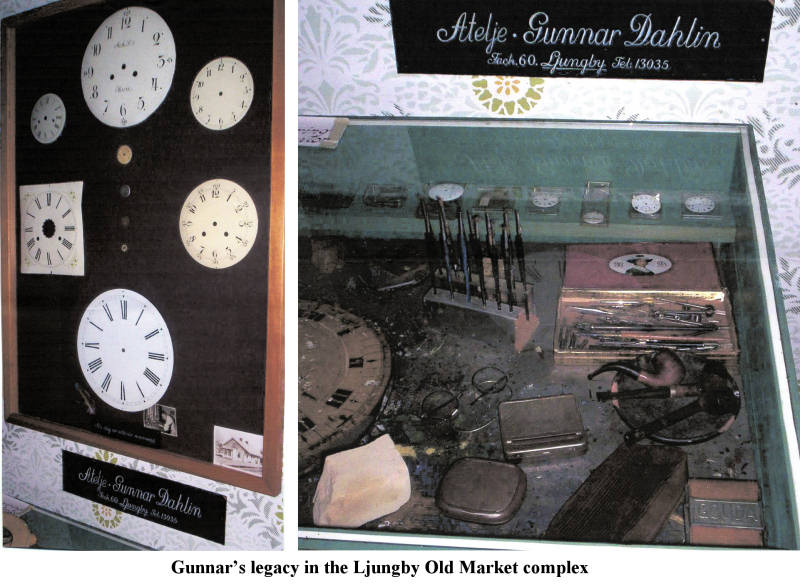Gunnar Dahlin –Clock Restoration Magician
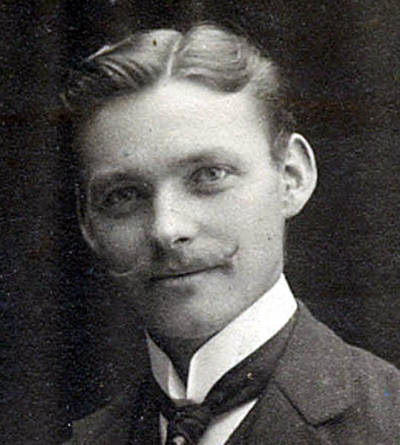 Gunnar
Dahlin – The handsome young mustached man in the attached
photo is Anders Gunnar Wilhelm Dahlin.
Gunnar
Dahlin – The handsome young mustached man in the attached
photo is Anders Gunnar Wilhelm Dahlin.
Gunnar began his life’s journey on July 17, 1885 in the little Småland
town of Nöttja. This journey from the woods and waterways of his
youth, that he dearly loved, carried him to an urban city in the United
States and later to Stockholm.
During his middle age he was fortunate enough to parley a hobby into an
established business that allowed him to move back to Småland and
rekindle his love of nature along with a daily opportunity to hunt or
fish.
This business was the restoration of old clocks and in particular clock
faces. Two extensive newspaper articles about Gunnar business were published
in Småland newspapers in the 1950’s and later in1962. Within
these articles it indicated that Gunnar was a “clock restoration
magician” and that he was recognized throughout Scandinavia for
these special skills.
Evidence for these unique skills fortunately have been preserved. His
special tools and some of his work are currently on display in the Ljungby
Old Market museum complex. Of particular interest, his display is on the
second floor of the old restored tannery that his father Erik Dahlin purchased
in 1891 and his older brother Werner owned and operated for fifty years.
This little vignette is an attempt to provide some insight in the life
of Gunnar Dahlin. It includes recollections from people who knew him,
translations from Swedish newspaper articles including his obituary along
with USA and Swedish archival records. Photos from his life including
those of his children are also provided.
Childhood Years Information
regarding Gunnar’s early years is limited but review of church records,
input from people who knew the Dahlin family and newspaper articles provide
speculation.
Gunnar’s mother born Anna Andersson was a Nöttja native whose
family lived in the area for many generations. She married the tanner
Eric Gustaf Dahlin in the Old Nöttja church in 1885. Eric, a widower
from Ljungby, had four children from his previous marriage. Eric owned
or worked in the Nöttja tannery.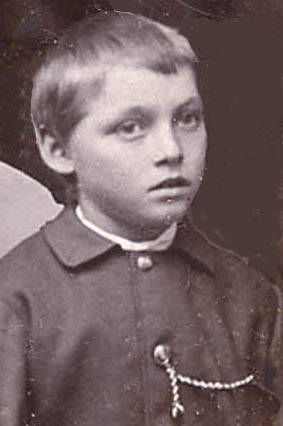
Gunnar was born in 1885. The previous year the Dahlin’s lost three
children to Scarlet Fever. That left Gunnar as an infant, with a 15 year
old step brother Gustaf, a sister Emma age eight and a brother Werner
age seven. A brother Carl was born two years later in 1877. So one can
assume since Gunnar and Carl were only two years apart they played together
as children.
In 1890 Gunnar’s stepbrother Gustaf died and the following year
the family moved to Ljungby.
One can also assume that Gunnar sang in the church choir. His mother Anna
and brother Werner were identified as being good singers. His sister Emma
who immigrated to Jamestown New York in 1896 was recognized in that community
for her beautiful singing voice. As an adult Gunnar was known to have
a rich baritone voice; his obituary stated that he was a devoted singer
and that he participated in men’s choirs in Uppsala, Stockholm and
later in Ljungby.
Gunnar likely showed early artistic talents; which is supported by the
special skills shown in his clock restoration business. In addition his
daughter, Inga, said that when he was in his sixties he built his own
violin that he enjoyed playing..
Further, it is easy speculation that as a youth Gunnar spent many hours
fishing and hunting. As an adult he was known as a lover of nature. Hunting
was one of his big interests and he was recognizes as one the founders
of the Ljungby shooting association. One can easily see him as a youngster
bringing home some small fury creatures to his father’s tannery
for hide preservation
His obituary also indicated he completed secondary school that was beyond
the compulsory elementary school provided to all Swedes at the time. Gunnar
was reported to be an outstanding athlete and a good long distance runner.
What he did after completing secondary school is unclear. Perhaps he worked
at his father’s tannery or at some local Ljungby business. In any
event, at age seventeen with assumed new and better opportunities he decided
to emigrate to the USA.
USA Adventures Gunnar, at age 17, traveled to the USA
with his sister 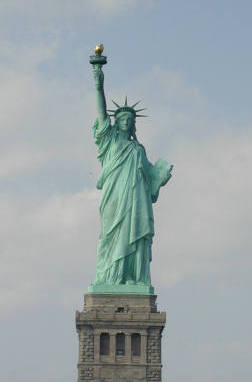
Emma who was then 26. Ellis Island passenger records and related ship
manifest records provides insight on Gunnar and Emma’s travel and
destination. Gunnar and Emma left Liverpool England January 24,1903 aboard
the British ship Saxonia. They arrived in New York’s Ellis Island
immigration center February 4,1903. The Saxonia, built in 1900 held 1960
passengers; it was owned by the same company [Cunnard Line] that later
launched the Titanic. The passenger record indicated that both Gunnar
and Emma started their journey from Helsingborg Sweden. Helsingborg is
a port city on the western coast of southern Sweden that is not to far
from Ljungby. Helsingborg claims the title as Sweden’s “Gateway
to the Continent”. It is separated by the Baltic Sea at the closest
point to Denmark. In 2005 Helsingborg ran 125 daily ferry crossings. It
is likely the two Dahlin’s continued onto Copenhagen picking up
a seagoing vessel to Liverpool England. Note: Gunnar’s younger
brother Carl Dahlin’s US citizenship papers show him as a resident
of Ljungby Sweden and that he immigrating to the US from Copenhagen Denmark.
The Saxonia’s manifest showed Gunnar
as a laborer and Emma as a domestic with their destination as Jamestown
New York. More specifically, they were going to join their Uncle Gustaf
Anderson whose address was 17 Center St. in Jamestown. Gustaf was Anna
Anderson Dahlin’s youngest brother and a partner of a successful
clothing store in Jamestown. The 1903 –1904 Jamestown City directory
shows Gunnar as a clerk working at 219 Main St. that was the location
of Gustaf Anderson’s men’s clothing business. The Directory
also shows Emma working as a dressmaker and both she and Gunnar living
at Gustaf’s Center St. address.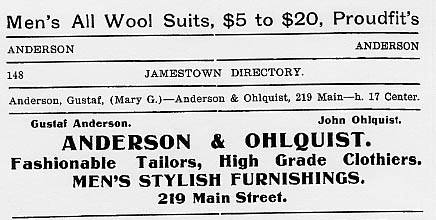
Gunnar returned to Sweden at an unknown date and later returned to Jamestown.
According to Gunnar’s grandson Bengt Blixt, Gunnar returned to Ljungby
where he met and married a local girl Edith Salmonsson. Their first child,
Karl Gunnar, was born May 9,1911. In 1912 Edith, then pregnant, moved
with her young son Karl Gunnar, back to Jamestown. Gunnar followed at
later date. Sadly, according to Jamestown’s Lake View Cemetery record
“ An infant daughter of Gunnar and Edith Dahlin died January 14,1913.
She is buried in Mound #2, Row 11, Grave #82” The cemetery records
also indicate the child only lived 30 minutes and died because of complications
during birth. The attending physician was W. Nelson and undertakers, Henderson
& Lincoln who are no longer in business, made the funeral arrangements.
Gunnar and Edith lived at 187 Barret Ave at the time. The cemetery attendant
reviewing the old record speculated that the infant was buried the same
day.
Gunnar’s younger brother Carl immigrated to Jamestown in 1910 and
remained there until 1921. 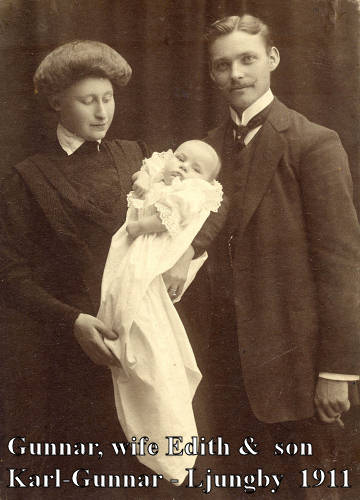 Consequently,
if there was any funeral for Gunnar’s infant daughter Carl and Uncle
Gustaf Anderson would have been there. In any event, during the time Gunnar
and Edith were in Jamestown they must have had some family gatherings
with Carl and Uncle Gustaf. It can be assumed that because Gunnar was
in Jamestown for more than a couple of years and worked in a retail business,
he spoke English.
Consequently,
if there was any funeral for Gunnar’s infant daughter Carl and Uncle
Gustaf Anderson would have been there. In any event, during the time Gunnar
and Edith were in Jamestown they must have had some family gatherings
with Carl and Uncle Gustaf. It can be assumed that because Gunnar was
in Jamestown for more than a couple of years and worked in a retail business,
he spoke English.
Back to Homeland Roots Gunnar, Edith and their young son Karl Gunnar moved back to Ljungby, Sweden probably about 1915. This date is a guess but is supported by the 1913-1914 Jamestown Directory that shows a Gunnar Dahlin living at 223 Broadhead. No other information is given in this entry; further his name does not show up in later Jamestown Directories. More convincing is that Gunnar and Edith had to be back in Ljungby in 1916 because their daughter Ingrid was born there on February 7,1916 The reason for Gunnar’s return to Sweden is unclear. Certainly, the loss of an infant daughter would have an impact. Perhaps the job opportunity was limited or perhaps he and Edith just wanted to return to their family roots. It can be assumed that after moving back Ljungby he worked there in some capacity.
Stockholm During 1916-1917
Gunner, Edith and their two children moved to Stockholm. However, they
still maintained family ties to Ljungby. Sometime between 1921 and 1923
the family returned to Ljungby to visit Gunnar’s parents [Erik died
Dec 28 1923]. Gunnar’s daughter Ingrid then somewhere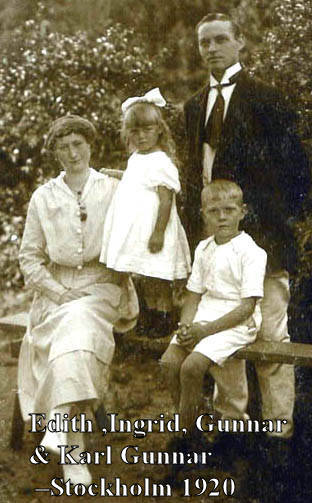 between 5 and 7 remembered standing trembling before the imposing figure
of her tall grandfather and saying: “ Good day, my name is Ingrid
Karilina Elisabet Dahlin.” This was her only conversation.
between 5 and 7 remembered standing trembling before the imposing figure
of her tall grandfather and saying: “ Good day, my name is Ingrid
Karilina Elisabet Dahlin.” This was her only conversation.
Initially, Gunner worked in a men’s clothing store. However, at
some point Gunnar and his wife Edith opened a retail shop in Stockholm
where they sold porcelain and kitchen related items. According to Gunnar’s
grandson, Bengt Blixt, the business did not do very well and they eventually
dropped this business. Bengt was left with the impression that Gunnar
was not much of a businessman.
On the other hand, while in Stockholm, as a favor to a friend who was
a clockmaker he repaired the damaged clock-face of his friend’s
clock. He succeeded better than expected and began renovating more clock
faces for his clockmaker friend and started thinking seriously about pursuing
this distinctive handicraft as a business that he could operate by himself.
As his skills grew he began going around to clockmaker shops in Stockholm
getting orders for renovation of clock faces and eventually opened his
own business
During WW2 it became completely impossible to get the special marten-hair
brushes that were used to paint figures and fine points. Gunnar started
to search for a substitute to make his own brushes and the first victim
was his wife’s nice fox fur boa from which he carefully pinched
some hair here and there.
Edith soon discovered the problem with her boa. Gunnar trying to defend
himself responded with: “It is the moths that have been there”.
Her quick response was: “Then it is probably a moth with its own
scissors”. Unfortunately, the fox hair was not an adequate solution
because it did not have the necessary elasticity. Consequently, Gunner
began his search for alternatives. After extensive searches he eventually
found acceptable hair type in a cow ear and wild mink! Even then, the
choice of brushes is so important that with the hundreds of brushes there
are only a few that were acceptable.
Clock Restoration Magician. Expensive
and antique clocks are subject to wear from weather and use and restoration
can significantly increase value and application. Taking advantage of
the demand to restore them Gunnar not only developed brushes, but special
tools, and materials. He became so skilled in this task that his reputation
spread not only in Sweden but also to all the Nordic countries. Clock
faces of all kinds were restored to their original brilliance through
his handiwork. This included small watches with the size of a “
10-öring” [an old Swedish coin with a diameter of 15m [0.43
in] to bank, railroad station or church clocks with faces up to 110 cm
[43 in.] Gunnar could classify old clocks and restore clock faces to their
original composition because of his vast knowledge in the history of old
clocks.
A newspaper article underscored his unique skill by indicating he could
paint a clock face on the head of a pin. These clocks may have cracked
mother -of -pearl or metal faces where he developed special materials
to hide the repair. In addition to clock faces, Gunnar also repaired laboratory
instruments. He also did some repair of clock mechanisms but this was
not his specialty. The newspaper author also suggested that Gunnar was
some kind of a magician with the materials he developed in his restoration
efforts and quizzed him about these materials. Gunnar, in response to
the question merely smiled. In other words he wasn’t going to tell
him. 
Målaskog Newspaper
articles and comments from family members clearly underscored Gunnar as
a lover of nature. Consequently, after living in the crowded urban setting
of Stockholm for many years Gunner and Edith later moved to the small
village of Målaskog. Målaskog, that is not far from Ljungby,
is located in Kronoberg County that is part of the Småland Province.
The village at the time was surrounded by evergreen forests and close
to good fishing; so this was an ideal place for Gunnar to purchase a home
that had room for his clock restoration business.
According to Gunnar’s grandson’s Bengt and Lars Erik Blixt
[ Gunnar’s daughter Ingrid married Curt Blixt] Gunnar and Edith
loved their grandchildren. Bengt stated that his brother Lars-Erik along
with their cousins Hans and Åke stayed several months during summer
holidays in their house in Målaskog when they were 8 – 15
years old.
“They really supported us and made our stay with them as the most
positive memories from our childhood.”
Bengt further wrote, “He {Gunnar} was really a “nature man”
and when he and his wife moved back to Småland, Målaskog,
(around 1948/49) he was lucky. He could now go out in the woods with his
dog and gun, get a hare or a fish from the lake and enjoy the life in
this nature setting.
In contrast, my grandmother, Edith, didn’t like this to move back
into the dark woods. She missed her sister, brother and son (Karl-Gunnar)
and daughter (Inga) and their families that still lived in the Stockholm
area.” 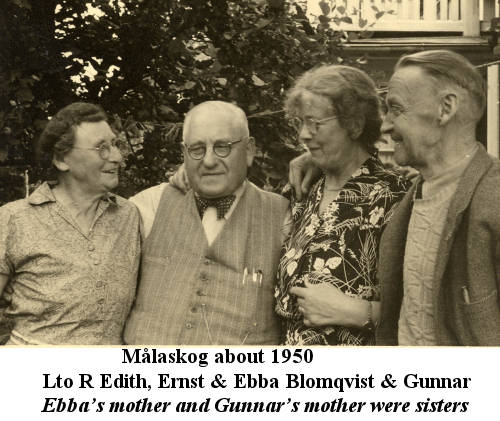
Bengt’s younger brother Lars-Erik added the following “ I
have spent several happy summer holidays in Målaskog with my brother
and cousins where my grandfather taught us to carve bows and make arrows
with iron nails in the front. The bowstrings were made of tendons that
he got from the butchers store. He also showed us how to make spears and
once I threw that sharpened spear at my cousin and suddenly there was
a small bloodshed from the hip. Boys!!!!”
Ljungby- Last Stop After Gunnar’s wife died he
moved back to Ljungby. A long article about Gunnar was published in the
Småland newspaper ‘Smålandsposten” in 1962 or
1963. The article had a large picture of Gunnar sitting at his workbench
but the picture quality was to poor to copy. This article translated from
Swedish included information previous shown. Consequently, this transcription
has been trimmed to present new information
Headline: “78-åring
skapar karaktär åt tidmätares ansikten”
Translation : ”78-years man makes characteristics to the
faces of time measurement devices”
Photo text: Gunnar Dahlin in his basement studio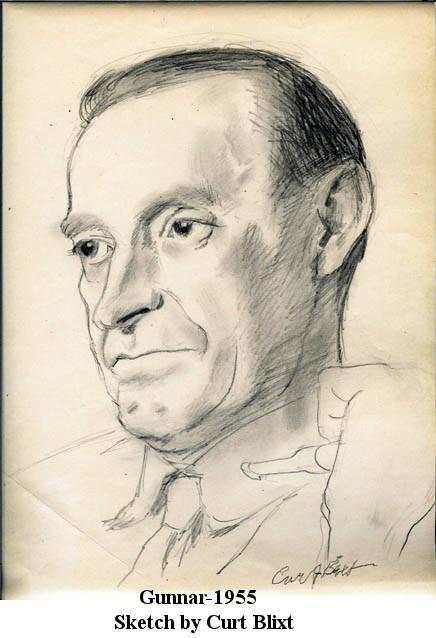
In a little basement room in Ljungby village
(should be town as Ljungby became a town in 1936) 78 year- old Gunnar
Dahlin sits among brushes, oils and paints working with a special art.
He is the only specialist of this art in the country, namely to renovate
antique clock faces of all kinds. With a safe hand he “brings out”
the original face of old clock faces, some with an origin from the 16th
century. He is well known for his skill and he gets orders from all parts
of our country. Most of his work concerns clock faces from old clocks
standing on the floor [ Probably what is referred to in the USA as Grandfather
Clocks] – These type of clocks have through the years grown in popularity
and have become very valuable.
In many cases these clocks are very old and exhibit clock faces that are
severely deteriorated to a point where they are barely readable. In some
cases the faces are covered with paint or they have been repainted by
a poorly skilled person..
To get down to the original clock face is a very time consuming process.
It is very important to slowly scrape the surface down to the originally
painted surface, which often has a signature or a name of the manufacturer.
Gunnar Dahlin was born “sunnerboit” (=person from Sunnerbo,
a county outside Ljungby), He was the son of a tanner from Nöttja,
His father also operated the old tannery that is still left as a cultural
monument in Ljungby.
In his old-age he moved back to his home district and settled down in
Målaskog; then some years later he moved to Ljungby.
Nowadays his profession is primarily a hobby, but he is not without orders.
A proof of his continued skill is the ability to, with the help of a marten-
hair brush, draw a clock face on a pin head! This profession – a
profession without a school – has taken a lot of time with experimenting
to get the right paint and contrasts. It also requires working with acids
and other chemicals and most important, a great amount of patience is
demanded. Antique treatment of the clock faces is also one of his specialities.
The terminology is known as “cracking” where you obtaining
a cracked surface in the paint.
His profession also demands an extensive knowledge about clocks from different
ages. Some years ago Gunnar Dahlin obtained a clock face for renovation.
The clock was made in the days of Karl XII (King of Sweden, lived 1682
– 1718). The clock had Arabian lettering and was signed by two brothers
with the soldier name “Stålknapp” (Steelbutton). Gunnar
Dahlin considered, unlike the owner of the clock face, that the clock
face because of its age should have Roman figures. Using precise and difficult
scraping, Gunnar worked his way through several paint layers, where he
began to see fragments of Roman figures that only could be discerned in
certain lighting. This, however, was enough to get the clock face back
to its originally character and give justice to its age.
“It is fun to work with old clock faces and see what a magnificent
work was done on these clocks hundreds of years ago with limited means
available” This comment came from Gunnar Dahlin sitting at his desk
in his basement studio. While he was talking, bright daylight entered
the window directly down on a clock face that he is just about to finish.
However, town life has never attracted this man with this unusual handicraft.
His dream is still a little cottage in the countryside where as a nature
lover he can be close to the woods and the wilderness. Now, as a urban
citizen he seldom has the opportunity do this.
Gunnar’s Legacy
Gunnar died June 21, 1972. He was about one month short of his 87th birthday.
An earlier newspaper article about Gunnar when he lived in Målaskog
concludes by saying: “In the corner of his workshop there is excellent
old hunting weapon; that is a good reason for putting away responsibilities
of the day and head out into the pine forest peace.” One can easily
remember Gunnar for his love of nature. However his life transcends this
image. Perhaps a more appropriate legacy is based on an old American homily.
A nephew of Gunnar is buried in a military cemetery outside Syracuse NY.
At this nephew’s graveside ceremony the priest in his homily indicated
that when you die, you die three times. First when you exhale your final
breath, Second when you are lowered into the ground and finally when your
name is spoken for the last time.
Gunnar’s name will be spoken long past the people who knew him thanks
to his clock restoration display in the Ljungby museum. Here below Gunnar
Dahlin’s name you can see his smoke-pipe along with his special
tools and clock faces he restored.
